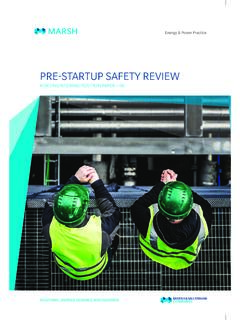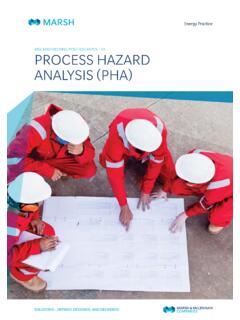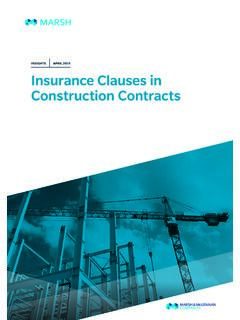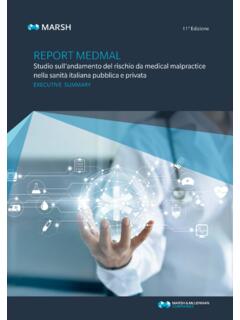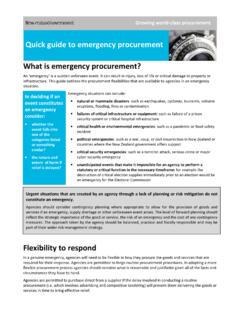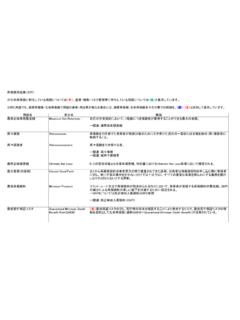Transcription of Ports & Terminals: Risk Challenges and Solutions
1 Ports & Terminals: Risk Challenges and SolutionsGLOBAL MARINE & CARGO PRACTICEI ntroductionThe geo-political landscape, automation, technological advances, changing regulations and a green agenda are all necessitating vast changes in the Maritime ecosystem. Geography and climate change cannot be underestimated either: the widened Panama Canal and the opening of the Northwest Passage and Northern Sea Route will each have their impact on global trading patterns. Freight carriers, handlers and logistics organizations are highly integrated through digitization and merger. Regulatory compliance and secure integration of operational and information technology will be more important than ever, bringing new opportunities for speed and accuracy, but also an increased vulnerability to new threats. The marine industry must adapt quickly, if it is to thrive in the future. At the strategic level, Ports and terminals and municipal authorities need to make bold investment decisions in this disrupted environment, whether it is channel widening, extending berthing, installing new bunkering infrastructure, new technology or merging new businesses.
2 At the operational level, Ports and terminals are confronted with emerging, rapidly accelerating and converging risks, which threaten contagion and aggregation, fresh liabilities, delays and interruption. And in all of this, Ports and terminals must have workforce strategies to protect port workers welfare, safety and to be able to retain, recruit and train employees for a future Marsh & McLennan Companies, we have. industry-leading experience and knowledge in the Ports and terminals sector. Our group creates value in strategic consulting (Oliver Wyman), workforce strategies (Mercer) and risk (Marsh).Life Cycle RiskMarsh s approach is based on the concept of life cycle risk, which refers to the changing pattern of a client s risk profile, from initial project development through the planning, design, financing, construction, and ultimately, many years of operation. By acknowledging that the Challenges and risk profile of an individual stakeholder to any project will change throughout the life of a project, our approach provides deeper insight into how risk issues and Solutions can span multiple phases of the JLT Specialty 1 StakeholdersThe risks inherent in a port development project or investment can be challenging and have far-reaching consequences for every stakeholder.
3 In many cases, stakeholders will be largely aligned in their perception of risk. However, differences in risk tolerance can lead to divergent approaches to risk allocation and mitigation SectorResponsibility: Protect the public interest and government assets through the life cycle of major : Manage mitigation and reduction of public sector risk to projects, resulting in the successful deployment of equity and public, private, and debt capital, improved contractual protection, project delivery, and operational InvestorsResponsibility: Maintain a competitive edge while protecting investors interests and satisfying contractual requirements agreed with customers, other stakeholders, and capital : Identify and quantify the pricing and transfer of risk to improve valuations, protect assets, and reduce the volatility of cash flows required to optimize operational performance, service fixed contractual obligations, and debt : Ensure that an in-depth risk review has been undertaken, assessing long-term suitability of borrower risk-retention and transfer strategy to protect lender : Identify gaps between project risks and the borrower s risk-retention and transfer arrangements; facilitate ongoing lender protection through borrower risk and insurance compliance provisions in finance and project : Deliver a project within time and budget, managing contingencies and controlling the cost of : Adopt a highly structured approach to the identification, evaluation, allocation, and management of significant and emerging project risk issues, and develop an optimal and cost-effective balance of risk retention and risk transfer that is supported by authoritative market knowledge and benchmark Service ProvidersResponsibility: Deliver architectural, engineering, and design consultancy with confidence in managing contractual, reputational, and geographic risks.
4 Delivery: Provide the most thorough and bespoke range of professional indemnity policy cover available in the global marketplace, coupled with superior claims handling service Ports and TerminalsMarsh JLT Specialty 34 Ports and TerminalsRisk Throughout a Life CycleProject Development/ConceptThe ability to manage risk efficiently decreases as a project life cycle proceeds; therefore, a project s development/concept phase is an important time to implement an effective risk management framework. Risks in this phase of a project can include: Poor scoping documents and lack of stakeholder input to project objectives. Insufficient time or budget allocated to feasibility studies. Inadequate site investigations, resulting in uncontrolled cost growth. Insufficient information in pre-design packages. Other risks more specific to risk management planning are unique to organizations. However, to ensure risks are allocated to parties best suited to address them, they should be addressed in a project s development/concept phase, including: Lack of a structured risk management framework to identify and manage risks.
5 Lack of transparency in key decision processes. Project objectives not aligned with the risk management plan. Undefined risk appetite for pre-design concept earlier our input is sought in the process of managing a new terminal project, the more support Marsh can provide. Our clients repeatedly find that an early discussion of coverage options allows them to make more efficient conceptual and contractual design decisions throughout the duration of their practical experience of Marsh colleagues goes beyond the insurance intermediary field into engineering and contractual support. Open discussions around the practicalities involved in the various risk-allocation options provide insight that enables the project team s negotiators to line up contractors in the most cost-efficient way prior to any site preparation. In addition, Marsh can provide insight into legal considerations related to a project s construction logistics and to the future operations, which will provide internal and external parties involved, whether private, commercial, or municipal, with the confidence they impact of international conventions proposed by the International Maritime Organization can be significant, as can proposals to change existing conventions; sometimes affecting the physical design specifications or operations.
6 Marsh can provide the necessary insight into these emerging risks. Examples include: New laws regulating ships emissions are creating demand for liquefied natural gas (LNG) or other clean fuels to be available in Ports . The implementation of more detailed port security in safety planning, has resulted in increased emphasis on site PlanningThe planning phase in a project s life cycle involves many issues that can be attributed to the complexity of collaboration between multiple stakeholders. The decisions made at this stage will have an impact later in the project. During this phase, a project may be halted or cancelled if financial terms and conditions cannot be met, the procurement process fails, or technological risks are deemed too high. The following are risks common to most stakeholders in this phase: Insufficient information to quantify the risk and calculate risk/reward. An inability to systematically identify high-risk bids during the procurement process, and the inclusion of legal and technical risks in the vendor selection.
7 The procurement strategy not being in line with risk transfer in insurance contracts. The use of unproven technology and/or time must be allocated to analyzing these risks to allow a bespoke risk-transfer program to be structured and marketed before construction JLT Specialty 5 Port/Terminal OperatorsMarsh assists operators in understanding, quantifying, and managing insurable risk exposures arising from proposed or actual ownership and operation of a port or terminal asset, including exposure to past, current, and potential liabilities. We also assess whether the insurance cover proposed for the project addresses risks appropriate for an international port or terminal operator, including non-damage business interruption. We also analyze the length of the business interruption insurance indemnity period, whether the insurance cover is compliant with insurance provisions contained within key commercial contracts entered into, the scope of insurance cover in respect of contract works that are the responsibility of the owner, and the adherence with statutory requirements to purchase insurance structured finance, the lenders are primarily concerned with the revenue-earning capability of the port anything that may impact its ability to operate in accordance with its business case and financial model, and its exposure to liabilities and many impose conditions within the terms of the loans.
8 In addition, the lenders will take security over the assets of the port, which includes the insurance and insurance proceeds and again may have strict requirements to the nature and extent of cover required. Common issues that arise include the entire supply chain and, in particular, the supply of the key lifting and handling equipment: who has risk and title, who procures the insurance during transit, erection, testing, and commissioning operation and who is the recipient of the insurance often the largest insurance-related delay in start-up risk is the cargo transit of the ship to shore cranes and container stackers. Meeting the needs of lenders for delay in start-up and insurance proceeds needs to be taken into account when negotiating the crane supply agreements. Lenders may even want to limit the number of cranes transported on any one vessel, which may result in an increased shipping cost. Similarly, lenders will want the port to be indemnified under the marine contractors protection and indemnity insurance.
9 Failing that, they will need some contingent marine liability cover during dredging and marine construction utilising marine craft. This is typically overlooked when employing marine contractors. Our structured finance team provides independent insurance and risk consultancy services to the providers of senior debt to structured finance projects worldwide, who may be providing up to 90% of the finance for the project and, therefore, have the most to lose if the project assist lenders in negotiating an appropriate insurance program for the construction and operation of the project, and advise on the management and mitigation of significant uninsured and commenting on the allocation of risk under the principal contracts is part of our PhasesPort development projects typically involve a mixture of onshore construction, buildings, warehouses and other facilities, and marine construction of jetties, breakwater, and quay walls, etc. (which are known as wet works ).
10 Due to the wide variety of unusual perils to which wet works are exposed, including extreme sea conditions and natural catastrophe , many construction insurers choose not to underwrite such risks, or instead offer low levels of capacity. The proportion of onshore construction to wet works, and the location of the project itself, will have a significant bearing on the perceived insurance risk, which means an understanding of risk exposures is all the more important in order to achieve the optimum risk transfer at the most competitive construction of warehouses and other onshore buildings and facilities are seen as very straightforward risks by insurers with both a relatively low risk of loss and relatively low associated insurable values. However, the arrival of cargo handling equipment onsite, typically during the later stages of the construction project, represents a delayed but significantly heightened build up of values that insurers will focus upon.
